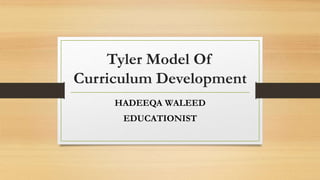
The Tyler Model of Curriculum Development
- 1. Tyler Model Of Curriculum Development HADEEQA WALEED EDUCATIONIST
- 2. About Tyler • • Best Known For The Basic Principles Of Curriculum And Instruction (Ornstein And Hunkins, 1998) Which Is Based On An Eight Year Study. • In His Book Tyler Presented The Concept That Curriculum Should Be: 1. Dynamic 2. A Program Under Constant Evaluation And Revision. “RALPH TYLER’S LITTLE BOOK, • Curriculum Had Always Been Thought Of As A Static, Set Program, And In An Era Preoccupied With Student Testing, He Offered The Innovative Idea That Teachers And Administrators Should Spend As Much Time Evaluating Their Plans As They Do Assessing Their Students.
- 3. • Tyler Also Explains That Curriculum Planning Is A Continuous, Cyclical Process, An Instrument Of Education That Needs To Be Fine-tuned. • Tyler's Straightforward Recommendations Are Sound And Effective Tools For Educators Working To Create A Curriculum That Integrates National Objectives With Their Students' Needs
- 4. THE TYLER MODEL • The Tyler Model Is: • One Of The Best Known Models For Curriculum Development. • Known For The Special Attention It Gives To The Planning Phases. • Deductive For It Proceeds From The General (Examining The Needs Of Society,) To The Specific (Specifying Instructional Objectives).
- 5. • Tyler Recommends That Curriculum Planners Identify General Objectives By Gathering Data From Three Sources: • 1) The Learners • 2) Contemporary Life Outside The School • 3) Subject Matter. • After Identifying Numerous General Objectives, The Planners Refine Them By Filtering Them Through Two Screens: • 1. The Philosophical Screen 2. The Psychological Screen
- 6. Tyler’s Four Fundamental Questions: • 1. What Educational Purposes Should The School Seek To Attain? • 2. What Educational Learning Experiences Can Be Provided That Are Likely To Attain These Purposes? • 3. How Can These Educational Experiences Be Effectively Organized? • 4. How Can We Determine Whether These Purposes Are Being Attained?
- 7. Model Is Consisting Of Four Steps • . 1. Determine The School’s Purposes (Aka Objectives) • 2. Identify Educational Experiences Related To Purpose • 3. Organize The Experiences • 4. Evaluate The Purposes
- 8. Determine The School’s Purposes (Aka Objectives) • Determining The Objectives Of The School Or Class. In Other Words, What Do The Students Need To Do In Order To Be Successful? Each Subject Has Natural Objectives That Are Indicators Of Mastery. All Objectives Need To Be Consistent With The Philosophy Of The School And This Is Often Neglected In Curriculum Development. For Example, A School That Is Developing An English Curriculum My Create An Objective That Students Will Write Essays. This Would Be One Of Many Objectives Within The Curriculum.
- 9. Identify Educational Experiences Related To Purpose • Developing Learning Experiences That Help The Students To Achieve Step One. For Example, If Students Need To Meet The Objective Of Writing An Essay. The Learning Experience Might Be A Demonstration By The Teacher Of Writing An Essay. The Students Then Might Practice Writing Essays. The Experience (Essay Demonstration And Writing) Is Consistent With The Objective (Student Will Write An Essay
- 10. . Organize The Experiences • Organizing The Experiences. Should The Teacher Demonstrate First Or Should The Students Learn By Writing Immediately? Either Way Could Work And Preference Is Determined By The Philosophy Of The Teacher And The Needs Of The Students. The Point Is That The Teacher Needs To Determine A Logical Order Of Experiences For The Students
- 11. Evaluation Of The Objectives • . Now The Teacher Assesses The Students Ability To Write An Essay. There Are Many Ways To Do This. For Example, The Teacher Could Have The Students Write An Essay Without Assistance. If They Can Do This, It Is Evidence That The Students Have Achieve The Objective Of The Lesson. There Are Variations On This Model. However, The Tyler Model Is Still Considered By Many To Be The Strongest Model For Curriculum Development.
- 12. Strengths Of Tyler’s Model • Clearly Stated Objectives A Good Place To Begin. • Involves The Active Participation Of The Learner (Prideaux, 2003) • Simple Linear Approach To Development Of Behavior Al Objectives (Billings & Halstead, 2009)
- 13. Criticism Of The Tyler Model • Narrowly Interpreted Objectives (Acceptable Verbs) • Difficult And Time Consuming Construction Of Behavioral Objectives Curriculum Restricted To A Constricted Range Of Student Skills And Knowledge Critical Thinking, • Problem Solving And Value Acquiring Processes Cannot Be Plainly Declared In Behavioral Objectives (Prideaux, 2003)
- 14. • TYLER’S MODEL • Deductive • Argues From The Administrator Approach • Believes That Administration Should Design The Curriculum And The Teachers Implement It • . Lays The Main Stress On Aims, Evaluation And Control. • This Approach May Be Perfect, Perhaps, For Market-oriented Education, But Inadequate For The Development Of Responsible And Creative Individuals Able To Meet The Challenges Of The Constantly Changing Circumstances • TABA’S MODEL • Inductive • Reflects The Teacher’s Approach • . Believes That The Teachers Are Aware Of The Students Needs; Hence Teachers Should Be The Ones To Develop The Curriculum And Implement In Practice • Her Rationale Does Not Start With Objectives, As She Believes That The Demand For Education In A Particular Society Should Be Studied First (See Step 1) • Pays Attention To The Selection Of The Content And Its Organization With An Aim To Provide Students With An Opportunity To Learn With Comprehension